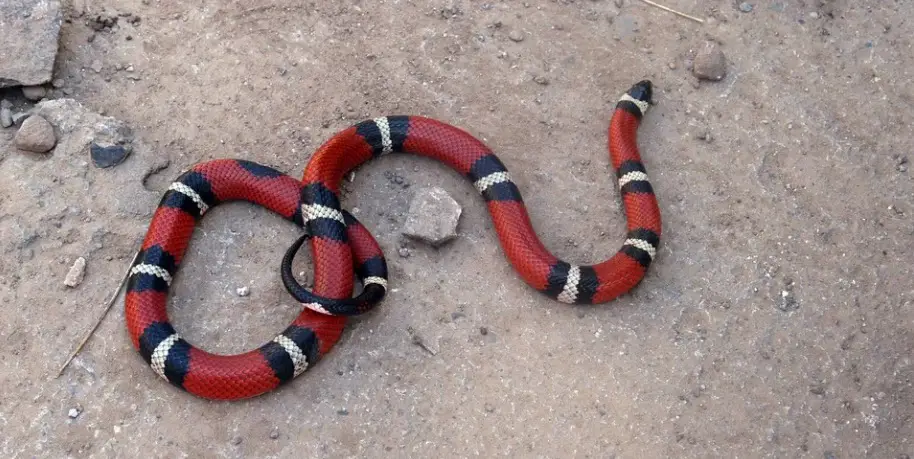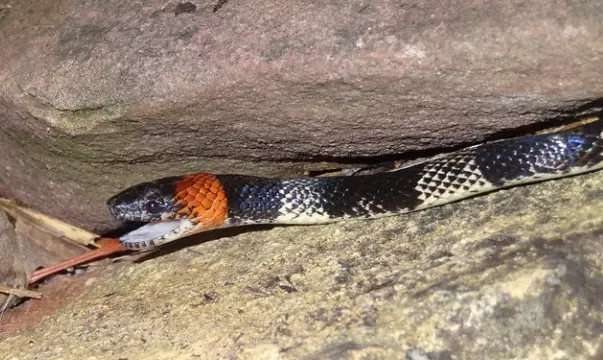Table of Contents
Coral Snake: All You Need To Know
A coral snake is a predatory venomous snake that belongs to the kingdom of Animalia, phylum Chordata, and class Reptilia. Its genuses are Leptomicurus, Micruroides, Micrurus, Calliophis, Hemibungarus, and Sinomicrurs, and it has more than 81 species. Its length is up to 91 cm. It lives in North America and is found in some coral reefs, with a lifespan of up to 7 years.

What is Coral Snake?
The term “Coral snake” refers to poisonous snakes in the Elapidae family, which includes six genera and at least 81 species. New World coral snakes (Leptomicrurus, Micruroides, Micrurus) and Old World coral snakes (Leptomicrurus, Micruroides, Micrurus) are the two main groups (Calliophis, Hemibungarus, Sinomicrurus). There are approximately 65 New World coral snake species and 16 Old World coral snake species.
Coral snakes in North America have distinct colour bands of red, yellow, white, and black. In the southwestern United States, this comprises the Eastern or Common coral snake (Micrurus fulvius), the Texas coral snake (Micrurus tener), and the Arizona coral snake (Micruroides euryxanthus).

Depending on the species, these bands may be pink, blue, white, or black in other areas of the world. In fact, several Old World species have no bands at all and are a single hue. The size of each species varies, although the majority of them are rather tiny. The typical length of North American species is 36 inches (91 cm), with specimens as long as 59 inches (150 cm) occasionally being reported. Their lifetime in captivity is usually around 7 years.
Coral Snake Diverse and Reclusive
Coral snake behaviour differs greatly due to the large number of species. Most species, on the other hand, are elusive, with many burrowing underground or spending much of their time amid the leaf litter on the forest floor. Some species, such as the South American Aquatic coral snake (Micrurus surinamensis), spend the most of their time in slow-moving waterways amid aquatic vegetation.
Coral snakes eat small mammals, amphibians, birds, and even other snake species, but their prey varies. They have two tiny, hollow fangs at the front of their mouth that they utilise to inject poison into their victims. Coral snakes lay between 2 and 7 eggs, depending on the species, but little is known about their mating and nesting practises due to their secretive nature.
They are among the most venomous snakes in the world. Because the venom’s strong neurotoxins can paralyse the breathing muscle, bites require emergency medical treatment. They are unlikely to bite people because of their solitary lifestyle and preference for isolated habitats.
Fun Facts About Coral Snake!
Because there are so many different kinds of coral snakes, they enable the study of apparently infinite, intriguing biological concepts like mimicry.
Coral Snake: Looks That Could Kill
Coral snakes are poisonous reptiles. They employ vivid colours, like many other venomous or deadly creatures, to warn other animals not to go too close. Interestingly, while not having the same protections as these creatures, there are many examples of animals that may imitate their colouring. In the animal realm, there are a few different types of mimicry.
An undefended species evolves to imitate another through Batesian mimicry to escape being eaten by predators that have learnt to shun creatures that look like them. The coral snake (Lampropeltis elapsoides) is closely resembled by the scarlet kingsnake (Lampropeltis elapsoides). It is not toxic, but its association with the more hazardous coral snake helps it.
Humans, for example, have devised a number of puzzles to help them figure out the difference in a pinch. For example, “Yellow on Black is Jack’s friend, but red on yellow will kill a fellow,” for example, alluding to the colour bands on the animals’ order. Unsurprisingly, these techniques’ dependability has been called into doubt.
Coral Snake: Tail, Scale, and Fin
Natural selection is a mechanism that permits animals to pass on adaptations that provide them a survival advantage from generation to generation. When an animal develops a characteristic that helps it to thrive in its environment as a result of a random mutation, that feature is passed on to the next generation, and so on.
Some water-dwelling coral snakes, for example, have developed flat tails that serve as fins. This enables them to swim far more effectively than their terrestrial counterparts, who have narrow, pointed tails.
Coral Snake: Origins in the Orient
Although the New World species appear to get the most attention, the Old World species really came earlier. In reality, genetic investigations have revealed that the oldest coral snake lineages originated in Asia. Some surviving Asian species have solid colouring rather than banded patterns, which sets them apart from their New World relatives.
Coral Snake Citations
- Snake bite: coral snakes. Clin Tech Small Anim Pract . 2006 Nov;21(4):183-6.
- Coral snake bites in Brazilian Amazonia: Perpetrating species, epidemiology and clinical aspects. Toxicon . 2020 Feb;175:7-18.
- Coral Snake Toxicity. PMID: 30085573







